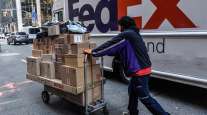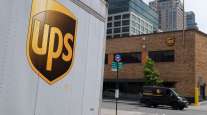Holiday Returns Drive Demand for Reverse Logistics

[Stay on top of transportation news: Get TTNews in your inbox.]
Reverse logistics is part of retailers’ year-round operations, but returns ramp up during the holidays.
“For 10 months of the year, you don’t hear about reverse logistics very often. You hear it more and more right around the holidays and Thanksgiving,” said Stephen McIsaac, senior vice president of brokerage operations at Nolan Transportation Group, a third-party logistics provider based in Atlanta.
Satish Jindel, founder of SJ Consulting Group, said the number of return parcels resulting from the peak holiday season is 130 million, which represents 5.3% of the total number of parcels that were shipped between Thanksgiving Day and New Year’s Eve.
PRESSURE ON RETAILERS: Returns create demand for reverse logistics
The United States Postal Service projected 800 million package deliveries between Thanksgiving and New Year’s Day.

Returned holiday gifts pile up on a counter at a Sears Store in Chicago. (Tannen Maury/Bloomberg News)
“This holiday season, during the months of December and January, we expect 18-20% of the volume to be return services, with additional returns continuing into March,” said Gary Reblin, vice president for new products and innovation at USPS.
For DHL, the return season really starts the week after Christmas.
“We’ll see consistent return volumes for at least a month and a half,” said Ryan Hunter, vice president for global customers at DHL Express Americas.
Returns spike after the holidays, with a record 1.9 million returns taking place on Jan. 2, said Jim Brill, reverse logistics and returns manager at UPS. “This is the official ‘National Returns Day,’ and the seventh consecutive record. In 2012, the number of returns was more than 520,000 on the peak day of Jan. 3. That means that the amount has nearly quadrupled since then,” Brill said.
Returns are moving earlier each year as shipping becomes faster and as consumers ramp up shopping before Black Friday, Brill said. “However, we don’t expect the January spike to ever go away, as returning holiday gifts is a time-honored tradition,” he added.
Ryan Kelly, vice president for global e-commerce marketing at FedEx, said the peak season isn’t a problem for those retailers that already have a solid returns strategy and the technology and capabilities in place internally and with their logistics providers. They can simply amp up the planning effort for the holiday season.
“For those retailers who struggle with returns or avoid returns, they are only going to grapple with more volume during peak,” Kelly said.

McIsaac
NTG’s McIsaac said a lack of planning from retailers and shippers can create challenges for logistics firms. “You’re trying to find a truck yesterday because you’re thrown shipments that are very rushed,” he said.
To keep packages moving during the holiday and returns period, USPS focused on preventive maintenance to ensure peak period readiness and identified additional space for peak annex operations, Reblin said.
Another challenge is being able to staff for the demand in the peak season, DHL’s Hunter said. To ramp up for holiday shipping, DHL hired 300 additional staff at its Cincinnati hub and added 72 permanent employees and 140 seasonal employees at a customer facility in Arizona.
Kelly said FedEx strongly encourages merchants to develop a returns strategy with their logistics providers whether their returns volume is large or small. “For FedEx, our peak planning with customers, which starts in January of each year, takes into consideration returns and its strong growth,” he said.
Want more news? Listen to today's daily briefing:




